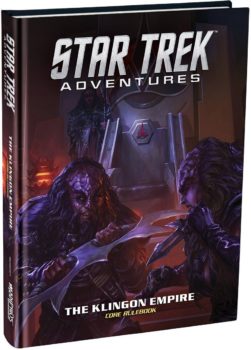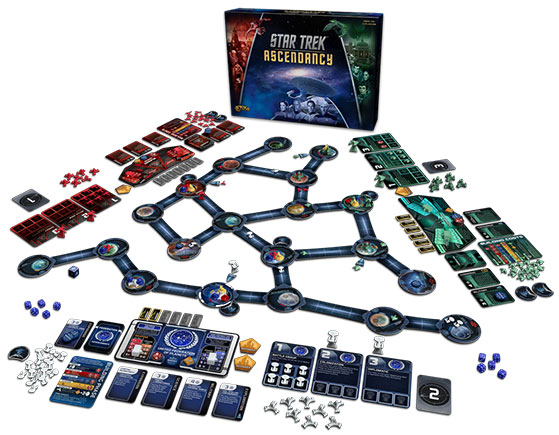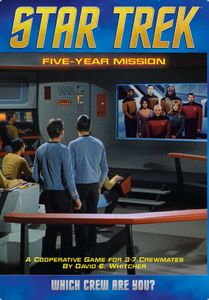The Season of Gaming: Star Trek

There has been something of a Star Trek television renaissance in recent years. Ranging from the all-too-near future (first contact with the Vulcans is slated to take place in 2063, after all) to the far distant future, the ever-growing setting provides ample fodder not only for new episodes and storylines, but for gamers who want to experience the universe by diving into the setting, there are a variety of different games that offer different levels of engagement with the themes of the show. And ones which, if you’re looking for a game to play while in lockdown with family over the holidays, might do the trick … particularly if your family consists of Trek fans.
One of the more curious Star Trek games I’ve run across was the Ferengi-themed sales game Star Trek: Galactic Enterprises, a card game where you spend bars of gold-pressed latinum in an effort to corner the market on a given product. There are of course the various games that are just re-skins of existing games that incorporate elements from the setting, like Star Trek Monopoly, various editions of Star Trek Fluxx, Star Trek Risk, and even Star Trek Catan.
But beyond those games, there are some which delve much more deeply into the concepts, alien species, and lore of the Star Trek universe to provide a more immersive gaming experience, boldly going where no game has gone before.
Star Trek: Ascendancy
For those looking for an epic board game experience within the Star Trek universe, there’s nothing to beat Star Trek: Ascendancy from Gale Force Nine. In this game, players represent the major powers of the galaxy, setting out to explore unknown regions of space from their assorted homeworlds. As they travel at warp speed to nearby star systems, they build an elaborate and unique board made up of randomized planets and space lanes between them. The discovery of a new world triggers an event from a deck of exploration cards, establishing whether the system is inhabited, as well as the technology level of any inhabitants, or any possible hazards to be encountered.
Players can colonize uninhabited worlds, but if the world is inhabited then the options are to either convince them to join with your empire or force them to through military might. As they gain these worlds, the players generate resources of Production, Research, and Culture, which is spent to build more starships, expand facilities on new worlds, or advance your technological capabilities. Ultimately, the goal is to be the first to reach 5 Ascendancy tokens, bought by generating enough Culture.

The asynchronous nature of the game is one of the most intriguing aspects, as each faction requires different strategies because of their different strengths and weaknesses. The Federation cannot gain control of planets by invading them, though they’re fairly good at convincing new planets to join their ranks. The Klingons, on the other hand, are particularly good at conquering through planetary invasions. Meanwhile, the Ferengi are horrible at conquest, but can achieve their goals by entering into mutually beneficial trade alliances with other larger factions.
The basic game comes with Federation, Klingon, and Romulan factions, with one of the big drawbacks being that it requires a minimum of three players. Additional expansions are available, adding Cardassians, Ferengi, Andorians, or even the Vulcan High Command as playable factions, along with new exploration cards and worlds to explore.
The most significant expansion is Borg Assimilation, where a randomly-activated Borg faction acts as an enemy that threatens to assimilate worlds and overrun the known galaxy with Borg cubes. These can be introduced as a separate faction that runs from the beginning of the game, or worlds and cards can be shuffled into the game that can spawn random Borg encounters. The expansion also allows for solo play or two-player modes, where the Borg represents an existential threat that has to be held off.
The game and expansions, along with a wealth of custom dice and miniature starships and starbases, are available at the Gale Force Nine store if you can’t find them at your local gaming shop.
Star Trek Adventures
For those looking for a more narrative experience, the Star Trek Adventures RPG from Modiphius games is definitely the place to look. We’ve reviewed these games repeatedly in the past, dating all the way back to when it was available through a public playtest in 2016. In that time, they’ve expanded throughout a variety of supplements beyond the Core Rulebook, including Quadrant Sourcebooks for all four of the quandrants in the Star Trek galaxy.
- The Continuing Mission: Star Trek Adventures
- Take Command of Star Trek Adventures
- Star Trek Adventures Is Versed In Multiple Techniques
- Boldly Go … With Star Trek Adventures RPG Playtest
The main sourcebooks focus on the Federation, of course, with releases of division manuals for the Command Division (covering Command and Conn officers), Operations Division (Security & Engineering), and Sciences Division (Science & Medicine). Though the starships and technology outlined in these sources are from the time spanning Enterprise through Voyager, there’s ample foundation in here to run stories set within that span the time between Voyager and Picard, or even to create stories in the hundreds of years between Picard and the third season of Discovery.
If you wanted to move beyond the Federation, Modiphius has also released an alternate Klingon Core Rulebook. The basic mechanics are the same as the existing Core Rulebook and supplements, with some revisions to the way Reputation works (focusing on gaining Glory and Shame points as a means of having more direct impact on play) and then a new section that includes building and developing original Klingon Houses. The majority of the text is focused on thematic differences between playing a Federation and Klingon Empire campaign.
These differences show up in some mechanics elements, of course. When figuring up the Reputation roll from an adventure, a Klingon campaign counts “Did you allow an insult to yourself, your ship, your crew, or your House go unchallenged?” as a negative influence against the roll, whereas there is no penalty for this in a Federation campaign. Most of the differences aren’t mechanical, though. The central role of Values as a means for driving the narrative in Star Trek Adventures leads to very different play between Federation and Klingon Empire adventures. The history and background sections include a lot of intriguing bits, like a passage that discusses a Ferengi point of view on the Klingon Empire, that are well worth diving into and provide some great story hook ideas.
All of these books are available from your local game shop, the Modiphius website, DriveThruRPG, and through Amazon.com.
Star Trek: Five-Year Mission
If you’re looking for a dice game, they have that too, with Five-Year Mission. In this one, you are playing Starfleet officers from the Enterprise on away team missions down to explore new planets. As you encounter challenges on the away missions, you need to accumulate appropriate values on dice of different colors to achieve your goals. Though I played this game once at a convention when it was under development, rather than going into a detailed description of it myself, probably best to direct you to the TableTop episode on Five-Year Mission.

Did you ever try Star Trek Fleet Captains from WizKids?
Its been sitting on my shelf for years but i’ve never given it an honest try.
I ran a game of STA just this past weekend. I’ve been skeptical of the 2D20 system, and I still feel it’s poorly explained, but we had an absolute blast!
Really great game. Can’t wait for more.
I definitely agree about that the explanation could be better. The details are spread out in the book across various sections, and it would definitely be better to have some consolidation.